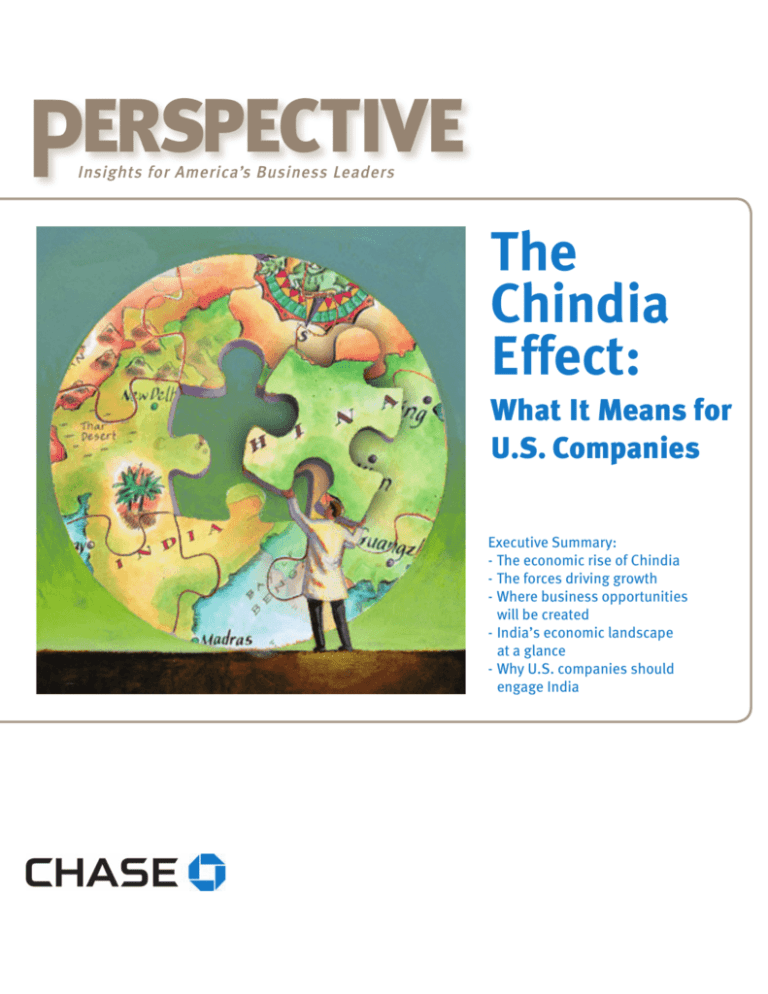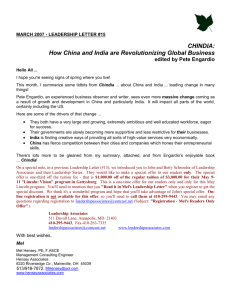
erspective
P
Insights for America’s Business Leaders
The
Chindia
Effect:
What It Means for
U.S. Companies
Executive Summary:
- The economic rise of Chindia
- The forces driving growth
- Where business opportunities
will be created
- India’s economic landscape
at a glance
- Why U.S. companies should
engage India
“People ask me
what about India
vs. China? But I ask
them what about
India plus China.
It’s being called
The Ascendancy of Chindia
Chindia.”1
As the world watches in awe, China and India are replacing their historic differences with a new form
of cooperative relationship – forged by closer economic links – and are rapidly emerging as two of the
most economically powerful nations in the world.
– Bill Gates
Chairman, Microsoft
Fueled by massive populations, huge domestic markets, cheap labor, and governments pursuing
investment-friendly policies, both countries are projecting their influence in virtually every aspect of
21st century global business.
Corporation
What will this Chindia Effect mean for U.S. companies? With the profound impact these two giants will
make on global commodities and consumer markets, U.S. business leaders can no longer afford not to
consider China and India.
An Economic Force
With annual growth forecasted at 8-10% for China and 8% for India in the foreseeable future, Chindia
is projected to have a 10.5% share of Global Domestic Product (GDP) at $6.3 trillion2 by the year 2020
and will, according to Hong Kong-based investment group CLSA:
• Make up 40% of the world’s total population
• Consume 50% of its natural resources
• Become the largest exporter of manufactured goods and services
For all the similarities in their rapid emergence, the development paths of China and India could not
have been more different. Let’s take a look at what’s powering this economic juggernaut:
China’s growth driven by:
• Foreign direct investment (FDI)
• Exports
• Large-scale manufacturing
• Economic Model: State Capitalism
India’s growth driven by:
• Consumption
• Vibrant capital markets
• World-class IT and services sectors
• Economic Model: Private Enterprise
It could be argued that China, with
its massive factories, serves as the
world’s workshop, while India, with
its fast-growing IT and outsourcing
sectors, is becoming the world’s
back office – both complementing
each other even as they compete for
resources.
GDP Adjusted for Purchasing Power
5SJMMJPO
1SPKFDUFE
$IJOB
64
*OEJB
Source: Economist Intelligence Unit
China and India are on a trajectory to join the U.S. as the top three global economic
powers by the year 2030.
2
This phenomenon is the genesis of
the word “Chindia,” coined by Indian
politician Jairam Ramesh to describe
their combined economic clout.3
“China and India will
be the two pagodas
of economic power in
the 21st century.” 4
– Wen Jiabao,
Demographic Drivers
Premier, People’s
China’s population – roughly 1.3 billion – is rapidly aging, and its low birth rate, attributed to
the government’s one-child policy, will cause a demographic drag on growth, according to Ms.
Jing Ulrich, Managing Director and Chairman, China Equities, JPMorgan. By 2015, one third of its
population will exceed 50+ years of age. At that point, China’s working-age population will peak
at 1 billion and then drop steadily.
Republic of China
India, with a population of 1.1 billion and a high fertility rate, will reap the dividends of a large,
young, and growing workforce. Projections indicate that by 2015, 58% of the population will be
below 29. By mid-century, India’s population is expected to reach 1.6 billion and 220 million
more workers than China.5
An aging population versus a young population
(Population by age group)
CHINA
INDIA
07&3
6/%&3
50+
30-49
15-29
0-14
2005
2015
2005
2015
Source: Clint Laurent, Global Demongraphics, Ltd. From Chindia, Beyond the Cliches,
by Jing Ulrich, Managing Director and Chairman, China Equities, JPMorgan.
Over time, the shifting age groups will determine which services,
products and industries will benefit each country, and where the
business and investment opportunities will be for U.S companies.
China’s growing “empty nest”
and “senior” populations will
make excellent targets for travel,
hotel, service, pharmaceutical
and insurance marketers.
India’s large “married with
children” segment – which
spends on food, education and
housing – will create business
opportunities for department
stores and supermarkets.
3
Consumer Market Drivers
Seduced by la dolce vita, hundreds of millions of new Chinese and Indian consumers are set to ignite
an investment and spending boom. The rise of this huge middle class will feed a rapidly growing
demand for household products and the raw materials used to make them.6
By 2020, it is projected that Chindia will have:
• One third of the world’s mobile subscribers and a $100 billion mobile handset market
• A $480 billion packaged food market, equivalent to 1-1/2 times the present U.S. market
• Bank loans valued at $9 trillion – twice the current GDP of Japan7
,PSFB
of the
Consumer
toformat
GDP, 2005
In China’sPercentage
retail sector,
modernDept
retail
accounts for over 30% of total retail sales. China
has been aggressively expanding its retail landscape to bring in more name-brand retailers and
class.
international luxury brands to satisfy the needs of its well-heeled middle 5BJXBO
India’s protectionist policies have kept large foreign retailers like Wal-Mart
and Carrefours out to
Conversely, India’s modern retail stores handle only 5% of total retail sales. As the “land of shopkeepers,”
protect the 100 million jobs in this area. Changes are coming, albeit slowly, as India begins opening
licensing agreements to meet rising
up its retail sector to foreign players through joint ventures and
demand for competition.
)POH,POH
4JOHBQPSF
Financial Market Drivers
.BMBZTJB
Financial sector assets in China are eight times larger
than India’s, with new lending far exceeding
5IBJMBOE
equity and debt issues over the last six years. However, capital market fund raising is tiny when
compared to bank
lending.
Percentage
of Consumer
Dept
Percentage
Dept to GDP,
2005to GDP, 2005
of Consumer
$IJOB
,PSFB
5BJXBO
)POH,POH
4JOHBQPSF
.BMBZTJB
5IBJMBOE
*OEJB
Common to both countries is a weakness in consumer
credit that remains underdeveloped as a result of:
$IJOB
$IJOB
*OEJB
.PSUHBHF
0UIFSDPOTVNFS
*OEJB
Source: CEIC. JPMorgan research by Samuel Chen. From Chindia, Beyond the Cliches,
by Jing Ulrich, Managing Director and Chairman, China Equities, JPMorgan.
$IJOB credit in Korea, Taiwan, Hong Kong and Singapore represents a
Consumer
substantial percentage of each country’s GDP – much less so when compared
*OEJB to India
and China.
4
With smaller financial sector assets, India’s distribution
.PSUHBHF
across loans, equity and debt issues is more balanced
than China’s.0UIFSDPOTVNFS
India has the advantage of strong capital
markets, which have grown 400% over the last five
years as a result of increased foreign institutional
a rise in domestic
investment
(FII) and
savings.
•
•
•
Banks tending to lend to companies and ignoring
consumers
A lack of established credit bureaus
Age-old attitudes towards acquiring personal debt
However, as income levels rise, and attitudes towards
debt begin to change, consumers will demand and be
supplied with more sources of credit. When matched
up with a fast-developing housing market, mortgages,
plus credit cards and personal loans, will become more
attractive growth opportunities for Chindia’s banks.
China’s explosive
growth has captured
the dragon’s share
of global interest,
and you may be more
familiar with that
part of the Chindia
equation. However,
the economic rise of
the Indian “Tiger”
has been no less a
compelling story in
its own right.
The Indian Moment
India is on the verge of something big. With globally competitive companies, thriving stock
markets, and a banking system that’s not saddled with bad loans, India is having a dramatic
effect on re-shaping the global economy by:
• Supplying the demand for a highly skilled, technically qualified, and relatively inexpensive
workforce around the world
• Putting more buying power in the hands of its massive middle-class consumer sector,
and creating a growing market for U.S. companies across multiple lines of business
• Moving towards the full convertibility of the Indian Rupee enabled by its growing foreign
exchange reserve
Opening India’s Economy
To accelerate its economic growth, India needs better infrastructure, more foreign investment,
and a more open policy towards foreign trade. Fortunately, the Indian government has undertaken
a number of initiatives to address these needs by:
• Relaxing and simplifying regulations for setting up a business
• Showing greater willingness to allow more foreign ownership in selected sectors
• Establishing special economic zones (SEZ)
Historically, wherever the government has loosened control and moved out of the way,
industries like India’s renowned IT and services sectors have flourished. Combine this
liberalization with an annual private sector growth rate of 15%, and this bodes well
for India’s rapidly emerging retail, real estate, infrastructure, healthcare and energy
markets.
FDI for infrastructure, a critical requirement for India’s future, is expected to double
in 2006-2007, with huge investments coming in the software, financial services and
manufacturing sectors, according to Kamal Nath, India’s minister of commerce.8
The country’s FDI needs should also get a much-needed B-1 shot now that S&P Rating
Services has upgraded India’s credit rating to investment grade from non-investment
grade or “junk” status. Analysts project that the higher rating will boost FII into stock
markets and FDI into new projects and infrastructure.9
The Indian Economy At-A-Glance
• GDP of $750 billion
($3.7 trillion on PPP terms)
• Per capita GDP of $700
($3,400 on PPP terms)
• FX reserves of $162 billion
• GDP growth rate of 7%+
India is also enjoying a strong and growing economic relationship with the U.S.
Bilateral trade has grown over the last five years with two-way trade in goods increasing from
$14 billion to over $26 billion.10 The U.S.-India Trade Policy forum, a key strategic agreement
established in 2005, is enabling the enhancement of trade and investment flow, supporting
economic reform, and improving market access to goods and services between the two countries.
5
A Sound Strategy for American Companies
India’s burgeoning economic and business environment offers U.S. companies practical reasons
and diverse opportunities for operating there. Start with its inexpensive supply of talent, its deep
financial markets, and the one sixth of the world’s consumers who live there, then consider its:
• Educated and hard-working labor force
• 200 million strong – and growing – middle class
• Stable, free-market democracy
• Established legal system
• English as the primary business language
• Clear guidelines for Intellectual Property Rights
• Domestic consumption-led growth
• Export competitiveness in select industries
Factor in India’s young and burgeoing population over the next several decades, plus a healthy
increase in infrastructure investment and growth, and you’ll quickly grasp why India is taking its
place as an emerging economic power.
India’s Infrastructure By Industry
&OFSHZ
5FMFDPN*5
5SBOTQPSUBUJPO
$PNNFSDJBM*OEVTUSJBM
0UIFST
Source: Developing an India Strategy, by Vishal Bharat, Senior Vice President,
JPMorgan Chase.
Infrastructure in India is growing aggressively as a result of increased government
commitment, linking the economic benefits from infrastructure, and encouraging
greater private sector participation.
6
“Western nations must
prepare for a future
dominated by China
and India, whose rapid
economic rise will
soon fundamentally
Dancing With the Dragon and the Tiger
alter the balance
By the year 2050, the E7, the world’s seven emerging economies – China, India, Russia, Brazil,
Indonesia, Mexico and Turkey – will overtake the economies of the G7 – U.S., Japan, Germany,
UK, France, Italy and Canada.
of power.” 11
– James Wolfensohn,
In this scenario, China and India will lead the E7 pack12 and create exciting business and
investment opportunities for savvy U.S. companies across multiple markets, including
consumer, agricultural, industrial, banking and logistics.
former World Bank
President
There is no denying that Chindia faces significant economic challenges. China’s state-owned
companies are financially troubled, the financial industry is debt ridden, and the economy
is open, but politics remain tightly closed. India is weak in industrial fundamentals, lags in
manufacturing, and lacks social infrastructure.
For all of that, Chindia will become an economic superpower to be reckoned with –
and one that corporate America must engage
This issue of Perspective is the first in a series of publications for executive
business leaders compliments of Chase Commercial Banking. Each in-depth
report is designed to present you with relevant news you can use on
emerging business issues. For more information, please visit us online at
www.chase.com/NewsYouCanUse.
7
Bibliography
1. Pesek, William, India, China or Chindia – Which is Asia’s real sleeping giant?,
The Age Company, Ltd. January 31, 2006.
2. Chindia Strengths, CLSA, Chindia Strategy, 2005.
3. Durner-Feiler, Zoe, Wolf, Greg, The Chindia Phenomenon, Passport to Profit,
www.wtcak.org, June 2006.
4. Dhillon, Amrit, Return of the Silk Road, Sunday Business (London), July 30, 2006.
5. Engardio, Pete, Chindia - How China and India are Revolutionizing Global Business,
McGraw-Hill, 2007, page 20.
6. Stevenson, Tom, Kleinman, Mark, China-India Tsunami of Consumer Demand Looming,
www.telegraph.co.uk, November 23, 2006.
7. Unstoppable Chindia, Hindustan Times, October 15, 2005.
8. Yee, Amy, FDI in India expected to double, Financial Times, FT.com, December 28, 2006.
9. India makes it to “investment grade,” The Indian Express.com, January 31, 2007.
10. U.S. and India Issue Joint Statement on Trade, Trade Facts, Office of the United States
Trade Representative, www.ustr.gov, March 2, 2006.
11. Iyer, Meenakshi, Chorus at WEF: Chindia has arrived, Hindustan Times.com,
January 31, 2007.
12. Hawksworth, John, The World in 2050, PriceWaterhouseCoopers, March 2006.
Selected information sourced from: Ulrich, Jing, Chindia – Beyond the Clichés,
“Hands-On China Publications, China Equities, JPMorgan, November, 2006.”
Copyright 2007 J.P. Morgan Chase & Company. All rights reserved.
Chase is a marketing name for certain businesses of JPMorgan Chase & Co.
and its subsidiaries worldwide.








